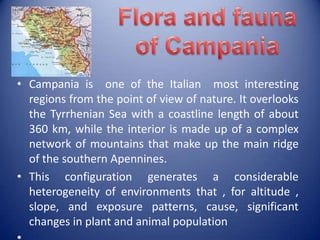
Italian flora and fauna
- 1. • Campania is one of the Italian most interesting regions from the point of view of nature. It overlooks the Tyrrhenian Sea with a coastline length of about 360 km, while the interior is made up of a complex network of mountains that make up the main ridge of the southern Apennines. • This configuration generates a considerable heterogeneity of environments that , for altitude , slope, and exposure patterns, cause, significant changes in plant and animal population
- 2. Mountain Plain Hill
- 3. The vegetation shows characteristics related to the climate, characterized by hot, dry and long summers and mild and rainy winters . These climatic conditions favour the life of evergreen shrubs and trees. The floristic composition of the "Mediterranean" is characterized mainly from "sclerophyllous species" SCLEROFILLIA (from: Scleros = hard and fillon = leaf).: evergreen trees and shrubs in compact compact , with hard, rigid, and leathery leaves. Typical shrub species : They are part of the Mediterranean species that share some characteristics (low growth, strong trunks, , stiff and leathery leaves) which make them able to tolerate the salty winds that blow from the sea. Typical Tree species : The trees are faced with long periods of dry soil, so they are usually evergreen or shrubs and herbs. The pines (Pinus halepensis, Pinus pinaster, Pinus pinea) and, above all, the holm oak (ilex Querus) represent the natural species of the place.
- 5. •The Mediterranean scrub is not uniform throughout the coastal territory and, due to the different condition of the soil and to the rainfall, different types of plants can grow: oak, broom arbutus(Fig. 1), myrtle, laurel, rosem ary, sage, cistus (fig.2), and juniper etc…. • In places with a drier climate, flora is becoming harsher, and the leaves are transformed into spines.
- 8. The type of vegetation that predominates on the reliefs of Campania, is in particular the oak forest (Quercus pubescens) and a scrub mixed with flowering ash (Fraxinus ornus) and hornbeam (Ostrya carpinifolia). Although less common, some importance is attached to forests of Quercus cerris , alder (Alnus cordata). and maple. The last one goes up to the heights of 1000 meters. Quite substantial extensions are occupied by chestnut coppices that man has certainly encouraged at the expense of the original forests . There you can find the beech woods that climb up the slopes up to 1500 meters.
- 9. The native fauna of the Campania region is now considerably reduced because of the high population density present above all in coastal but also in inland areas. However It is possible to recognize some varied environments that allow us to distinguish: reptiles birds mammals fish fauna
- 10. Reptiles count dozens of species: Turtles (Caretta caretta - fig.1). Worth noting is their regular transit into the seas in front of the coasts of Campania Tortoise (Testudo hermanni). Extremely rare limited to a few isolated populations There are also: the Gecko (Tarentola mauritanica) the wall lizard (Podarcis muralis) the sand lizard (Coluber viridiflavus) the viper (Vipera aspis) The tessellated snake (Natrix tessellata) in the humid valleys of Lattari
- 11. Numerous species of birds have been counted so far in the region. Of these, almost half are certain or probable nesting. As regards the phenomenon of migration and wintering, the region has a decisive international role. The coast, the headlands, the islands and the ponds behind the dunes, are the sites of greatest importance to the phenomenon of migration, both for species coming from the south of Africa and for the wintering of breeding populations in northern Europe.
- 12. It is really remarkable the presence of mammalian species in a region with such a high density of inhabitants: Wolf (Canis lupus - fig.1) Otter (Lutra lutra - fig.2) There is, also, the presence of nuclei of: Wild boar (Sus scrofa), European hare (Lepus europaeus) Weasel (Mustela nivalis), Marten (Martes weasel) Hedgehog (Erinaceus europaeus) Fox (Vulpes vulpes), Rinolfo greater (Rhinolophus ferrumequinum)
- 13. The pupils of the "Comenius" project with the expert marine biologist during the implementation of the activities related to the study of fish fauna
- 15. alice alalunga argentina tonnetto Aguglia Alaccia aguglia imperiale aguglia imperiale -marlin blu anguilla
- 16. murice polpo calamaro cannolicchio moscardino tellina cozze vongola fasolaro Vongola verace
- 17. Mazzancolla Gambero rosso Pannocchia Aragosta Scampo Astice